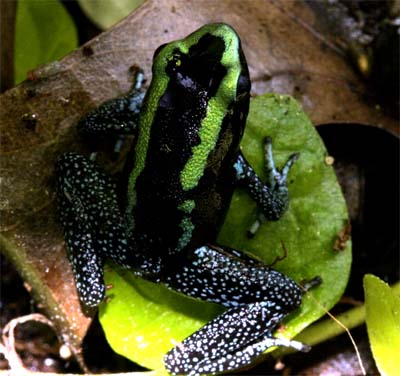|
Phyllobates aurotaenia are a really cool frog. These frogs along with P. terribillis and P. bicolor are probably the most toxic of the poison dart frogs in the wild. In captivity all these frogs lose their toxicity but none of their boldness. Auros do not get as big as terribillis or bicolors but they have just as much personality and some people think a nicer call. There are 3 commonly available color morphs: green banded (pictured here) orange/yellow banded and the wide banded. We believe that these are the ideal beginner dart frog, but they are not commonly available. P. aurotaenia are not fussy eaters and accept a large variety of foods, and some large food items. It is pretty amazing watching these guys tackle crickets that are ¼ their size. Another point for the beginning frogger is that our P. aurotaenia rarely hide, so the frogs are easily observed even in a well-planted terrarium. We keep our P. aurotaenia in a well planted vivarium with a lot of leaf litter. They often use the upper 2/3 of the enclosure, and 2 of the 5 that we have usually in the upper leaves and branches of our larger plants. P. aurotaenia are probably the most arboreal species of Phyllobates we have. We do not have bicolor or lugubris but our aurotaenia climb much than our terribilis or vittatus. They also have a great call, we have 2 males in our breeding group and sometimes the males will square off face to face and call. This is the only aggression we have ever seen, which makes another point to select them as a good frog for beginners.
Phyllobates aurotaenia are fairly prolific egg layers, once they get started. The eggs are usually laid in a coco hut or similar bower. Ours lay most of the time in a film canister laid horizontally on the floor of the vivarium. We leave the eggs in the enclosure for at least 24 hours after finding them to make sure that they are fertilized. The hatch rate for P. aurotaenia eggs is sometimes low considering the large number of eggs deposited. We raise our tadpoles communally in a critter keeper or Rubbermaid container that is not filtered. There are pathos and aquatic plants in the rearing enclosure. Tads are fed a mixture of spirulina, chlorella, stinging nettle and vitamins (2:2:1:1), we also feed "Aquarian" and “Cyclopse-eze” fish food about once a week. We expose the tads to UVB lighting daily. They morph out fairly small but can eat Drosophila melanogaster that are dusted daily with Repcal. We also dust several times a week with Herptivite. We follow this dusting regime with our adult frogs too. The frogs reach maturity in 12-15 months. Males will start calling a couple months before females are ready to breed. The males and females are about the same size and body shape, so they are tough to sex by body comparison. |
 |
Our frogs have started breeding and have a loud pleasant call.
We have a 2:3 group and both males call at the same time. They are healthy and great eaters.
We got them from Jon Beetle. Jon is an experienced and knowledgeable frogger in the Philadelphia area and a great guy.
Summation:
Size- 24 - 34 mm, females are slightly larger than males
Care- Easy to care for
Food- all types of fruit flies, small- medium crickets, waxworms, confused flowerbeetle larvae, termites, field sweeping
Eggs and Tads- large clutches, tads are omnivorous and can be kept communally
Temperature- 70°-80°
|

